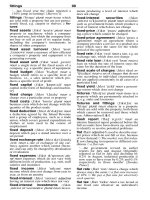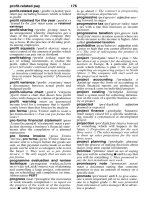Dictionary of mathematics terms
Bạn đang xem bản rút gọn của tài liệu. Xem và tải ngay bản đầy đủ của tài liệu tại đây (12.36 MB, 411 trang )
PROFESSIONAL
GUIDES
Dictionary of
Mathematics
Terms
Third Edition
• More than 800 terms related to algebra, geometry,
analytic geometry, trigonometry, probability, statistics,
logic, and calculus
• An ideal reference for math students, teachers,
engineers, and statisticians
• Filled with illustrative diagrams and a quick-reference
formula summary
Douglas Downing, Ph.D.
Dictionary of
Mathematics Terms
Third Edition
Dictionary of
Mathematics Terms
Third Edition
Douglas Downing, Ph.D.
School of Business and Economics
Seattle Pacific University
Dedication
This book is for Lori.
Acknowledgments
Deepest thanks to Michael Covington, Jeffrey
Clark, and Robert Downing for their special help.
© Copyright 2009 by Barron’s Educational Series, Inc.
Prior editions © copyright 1995, 1987.
All rights reserved.
No part of this publication may be reproduced or
distributed in any form or by any means without the
written permission of the copyright owner.
All inquiries should be addressed to:
Barron’s Educational Series, Inc.
250 Wireless Boulevard
Hauppauge, New York 11788
www.barrronseduc.com
ISBN-13: 978-0-7641-4139-3
ISBN-10: 0-7641-4139-2
Library of Congress Control Number: 2008931689
PRINTED IN CHINA
9 8 7 6 5 4 3 2 1
CONTENTS
Preface
vi
List of Symbols
ix
Mathematics Terms
1
Appendix
381
Algebra Summary
381
Geometry Summary
382
Trigonometry Summary
384
Brief Table of Integrals
388
PREFACE
Mathematics consists of rigorous abstract reasoning.
At first, it can be intimidating; but learning about math
can help you appreciate its great practical usefulness and
even its beauty—both for the visual appeal of geometric
forms and the concise elegance of symbolic formulas
expressing complicated ideas.
Imagine that you are to build a bridge, or a radio, or a
bookcase. In each case you should plan first, before beginning to build. In the process of planning you will develop
an abstract model of the finished object—and when you
do that, you are doing mathematics.
The purpose of this book is to collect in one place reference information that is valuable for students of mathematics and for persons with careers that use math. The
book covers mathematics that is studied in high school
and the early years of college. These are some of the general subjects that are included (along with a list of a few
entries containing information that could help you get
started on that subject):
Arithmetic: the properties of numbers and the four
basic operations: addition, subtraction, multiplication,
division. (See also number, exponent, and logarithm.)
Algebra: the first step to abstract symbolic reasoning.
In algebra we study operations on symbols (usually letters) that stand for numbers. This makes it possible to
develop many general results. It also saves work because
it is possible to derive symbolic formulas that will work
for whatever numbers you put in; this saves you from having to derive the solution again each time you change the
numbers. (See also equation, binomial theorem, quadratic equation, polynomial, and complex number.)
Geometry: the study of shapes. Geometry has great
visual appeal, and it is also important because it is an
vi
vii
example of a rigorous logical system where theorems
are proved on the basis of postulates and previously
proved theorems. (See also pi, triangle, polygon, and
polyhedron.)
Analytic Geometry: where algebra and geometry
come together as algebraic formulas are used to describe
geometric shapes. (See also conic sections.)
Trigonometry: the study of triangles, but also much
more. Trigonometry focuses on six functions defined in
terms of the sides of right angles (sine, cosine, tangent,
secant, cosecant, cotangent) but then it takes many surprising turns. For example, oscillating phenomena such
as pendulums, springs, water waves, light waves, sound
waves, and electronic circuits can all be described in
terms of trigonometric functions. If you program a computer to picture an object on the screen, and you wish to
rotate it to view it from a different angle, you will use
trigonometry to calculate the rotated position. (See also
angle, rotation, and spherical trigonometry.)
Calculus: the study of rates of change, and much
more. Begin by asking these questions: how much does
one value change when another value changes? How fast
does an object move? How steep is a slope? These problems can be solved by calculating the derivative, which
also allows you to answer the question: what is the highest or lowest value? Reverse this process to calculate an
integral, and something amazing happens: integrals can
also be used to calculate areas, volumes, arc lengths, and
other quantities. A first course in calculus typically covers the calculus of one variable; this book also includes
some topics in multi-variable calculus, such as partial
derivatives and double integrals. (See also differential
equation.)
Probability and Statistics: the study of chance phenomena, and how that study can be applied to the analysis of data. (See also hypothesis testing and regression.)
viii
Logic: the study of reasoning. (See also Boolean
algebra.)
Matrices and vectors: See vector to learn about quantities that have both magnitude and direction; see matrix
to learn how a table of numbers can be used to find the
solution to an equation system with many variables.
A few advanced topics are briefly mentioned because
you might run into certain words and wonder what
they mean, such as calculus of variations, tensor, and
Maxwell’s equations.
In addition, several mathematicians who have made
major contributons throughout history are included.
The Appendix includes some formulas from algebra,
geometry, and trigonometry, as well as a table of integrals.
Demonstrations of important theorems, such as the
Pythagorean theorem and the quadratic formula, are
included. Many entries contain cross references indicating
where to find background information or further applications of the topic. A list of symbols at the beginning of the
book helps the reader identify unfamiliar symbols.
Douglas Downing, Ph.D.
Seattle, Washington
2009
LIST OF SYMBOLS
Algebra
ϭ
Ϸ
Ͼ
Ն
Ͻ
Յ
ϩ
Ϫ
ϫ, #
Ϭ, /
equals
is not equal
is approximately equal
is greater than
is greater than or equal to
is less than
is less than or equal to
addition
subtraction
multiplication
division
2
square root; radical symbol
n
2
!
n
nCj,1 j 2
nth root
factorial
number of combinations of n things taken j at a
time; also the binomial theorem coefficient.
nPj
number of permutations of n things taken j at a
time
0x 0
∞
a b
2
2
c d
absolute value of x
infinity
determinant of a matrix
Greek Letters
p
pi (ϭ 3.14159...)
⌬
delta (upper case), represents change in
d
delta (lower case)
⌺
sigma (upper case), represents summation
s
sigma (lower case), represents standard
deviation
ix
x
u
f
m
e
x
r
l
theta (used for angles)
phi (used for angles)
mu, represents mean
epsilon
chi
rho (correlation coefficient)
lambda
Calculus
⌬x
dy
y¿,
dx
y– ,
d2y
dx2
0y
0x
S
lim
e
∫
increment of x
derivative of y with respect to x
second derivative of y with respect to x
partial derivative of y with respect to x
approaches
limit
base of natural logarithms; e = 2.71828.
integral symbol
Ύ f1x2 dx
indefinite integral
Ύ f1x2dx
definite integral
b
a
Geometry
ؠ
degrees
perpendicular
m
Ќ
perpendicular, as in ABЌDC
l
angle
᭝
triangle, as in ᭝ABC
Х
congruent
ٗ
xi
~
ʈ
4
S
similar
parallel, as in AB ʈ CD
៣
arc, as in AB
line segment, as in AB
4
line, as in AB!
ray, as in AB
Vectors
ʈ aʈ
a#b
aϫb
¥f
¥#f
¥ϫf
length of vector a
dot product
cross product
gradient
divergence
curl
៣
—
Set Notation
{}
braces (indicating membership in a set)
intersection
ʝ
union
ʜ
empty set
л
Logic
S
~p
¿
ٚ
IFF, 4
᭙x
E
implication, as in a S b (IF a THEN b)
the negation of a proposition p
conjunction (AND)
disjunction (OR)
equivalence, (IF AND ONLY IF)
universal quantifier (means “For all x . . .”)
existential quantifier (means “There exists an
x . . .”)
1
ABSOLUTE VALUE
A
ABELIAN GROUP See group.
ABSCISSA Abscissa means x-coordinate. The abscissa of
the point (a, b) in Cartesian coordinates is a. For contrast, see ordinate.
ABSOLUTE EXTREMUM An absolute maximum or an
absolute minimum.
ABSOLUTE MAXIMUM The absolute maximum point for
a function y ϭ f (x) is the point where y has the largest
value on an interval. If the function is differentiable, the
absolute maximum will either be a point where there is a
horizontal tangent (so the derivative is zero), or a point at
one of the ends of the interval. If you consider all values
of x (Ϫ∞ Յ x Յ ∞), the function might have a finite maximum, or it might approach infinity as x goes to infinity,
minus infinity, or both. For contrast, see local maximum.
For diagram, see extremum.
ABSOLUTE MINIMUM The absolute minimum point for
a function y ϭ f (x) is the point where y has the smallest
value on an interval. If the function is differentiable, then
the absolute minimum will either be a point where there
is a horizontal tangent (so the derivative is zero), or a
point at one of the ends of the interval. If you consider
all values of x (Ϫϱ Յ x Յ ϱ), the function might have a
finite minimum, or it might approach minus infinity as x
goes to infinity, minus infinity, or both. For contrast, see
local minimum. For diagram, see extremum.
ABSOLUTE VALUE The absolute value of a real number
a, written as 0a 0 , is:
0a 0 ϭ a if a Ն 0
0a 0 ϭ Ϫa if a Ͻ 0
Figure 1 illustrates the absolute value function.
ACCELERATION
2
Figure 1 Absolute value function
Absolute values are always positive or zero. If all the
real numbers are represented on a number line, you can
think of the absolute value of a number as being the distance from zero to that number. You can find absolute
values by leaving positive numbers alone and ignoring
the sign of negative numbers. For example, 017 0 ϭ 17,
0Ϫ105 0 ϭ 105, 00 0 ϭ 0
The absolute value of a complex number a ϩ bi is
2a2 ϩ b2.
ACCELERATION The acceleration of an object measures
the rate of change in its velocity. For example, if a car
increases its velocity from 0 to 24.6 meters per second
(55 miles per hour) in 12 seconds, its acceleration was
2.05 meters per second per second, or 2.05 meters/
second-squared.
If x(t) represents the position of an object moving in
one dimension as a function of time, then the first derivative, dx/dt, represents the velocity of the object, and the
second derivative, d 2x/dt 2, represents the acceleration.
Newton found that, if F represents the force acting on an
object and m represents its mass, the acceleration (a) is
determined from the formula F ϭ ma.
3
ALGEBRA
ACUTE ANGLE An acute angle is a positive angle smaller
than a 90Њ angle.
ACUTE TRIANGLE An acute triangle is a triangle
wherein each of the three angles is smaller than a 90Њ
angle. For contrast, see obtuse triangle.
ADDITION Addition is the operation of combining two numbers to form a sum. For example, 3 ϩ 4 ϭ 7. Addition satisfies two important properties: the commutative property,
which says that
a ϩ b ϭ b ϩ a for all a and b
and the associative property, which says that
(a ϩ b) ϩ c ϭ a ϩ (b ϩ c) for all a, b, and c.
ADDITIVE IDENTITY The number zero is the additive
identity element, because it satisfies the property that the
addition of zero does not change a number: a ϩ 0 ϭ a
for all a.
ADDITIVE INVERSE The sum of a number and its additive inverse is zero. The additive inverse of a (written as
Ϫa) is also called the negative or the opposite of a: a ϩ
(Ϫa) ϭ 0. For example, Ϫ1 is the additive inverse of 1,
and 10 is the additive inverse of Ϫ10.
ADJACENT ANGLES Two angles are adjacent if they
share the same vertex and have one side in common
between them.
ALGEBRA Algebra is the study of properties of operations
carried out on sets of numbers. Algebra is a generalization of arithmetic in which symbols, usually letters, are
used to stand for numbers. The structure of algebra is
based upon axioms (or postulates), which are statements
that are assumed to be true. Some algebraic axioms
include the transitive axiom:
if a ϭ b and b ϭ c, then a ϭ c
ALGORITHM
4
and the associative axiom of addition:
(a ϩ b) ϩ c ϭ a ϩ (b ϩ c)
These axioms are then used to prove theorems about
the properties of operations on numbers.
A common problem in algebra involves solving conditional equations—in other words, finding the values of
an unknown that make the equation true. An equation of
the general form ax ϩ b ϭ 0, where x is unknown and a
and b are known, is called a linear equation. An equation of the general form ax2 ϩ bx ϩ c ϭ 0 is called a
quadratic equation. For equations involving higher
powers of x, see polynomial. For situations involving
more than one equation with more than one unknown,
see simultaneous equations.
This article has described elementary algebra. Higher
algebra involves the extension of symbolic reasoning
into other areas that are beyond the scope of this book.
ALGORITHM An algorithm is a sequence of instructions
that tell how to accomplish a task. An algorithm must be
specified exactly, so that there can be no doubt about what
to do next, and it must have a finite number of steps.
AL-KHWARIZMI Muhammad Ibn Musa Al-Khwarizmi
(c 780 AD to c 850 AD) was a Muslim mathematician
whose works introduced our modern numerals (the Hinduarabic numerals) to Europe, and the title of his book Kitab
al-jabr wa al-muqabalah provided the source for the term
algebra. His name is the source for the term algorithm.
ALTERNATE INTERIOR ANGLES When a transversal
cuts two lines, it forms two pairs of alternate interior
angles. In figure 2, Є1 and Є2 are a pair of alternate
interior angles, and Є3 and Є4 are another pair. A theorem in Euclidian geometry says that, when a transversal
cuts two parallel lines, any two alternate interior angles
will equal each other.
5
AMBIGUOUS CASE
Figure 2 Alternate interior angles
ALTERNATING SERIES An alternating series is a series
in which every term has the opposite sign from the preceding term. For example, x Ϫ x3/3! ϩ x5/5! Ϫ x7/7! ϩ
x9/9! Ϫ . . . is an alternating series.
ALTERNATIVE HYPOTHESIS The alternative hypothesis is the hypothesis that states, “The null hypothesis is
false.” (See hypothesis testing.)
ALTITUDE The altitude of a plane figure is the distance
from one side, called the base, to the farthest point. The
altitude of a solid is the distance from the plane containing
the base to the highest point in the solid. In figure 3, the
dotted lines show the altitude of a triangle, of a parallelogram, and of a cylinder.
AMBIGUOUS CASE The term “ambiguous case” refers to
a situation in which you know the lengths of two sides of
a triangle and you know one of the angles (other than the
angle between the two sides of known lengths). If the
known angle is less than 90Њ, it may not be possible to
solve for the length of the third side or for the sizes of the
other two angles. In figure 4, side AB of the upper triangle is the same length as side DE of the lower triangle,
side AC is the same length as side DF, and angle B is the
AMPLITUDE
6
Figure 3 Altitudes
Figure 4 Ambiguous case
same size as angle E. However, the two triangles are
quite different. (See also solving triangles.)
AMPLITUDE The amplitude of a periodic function is onehalf the difference between the largest possible value of
the function and the smallest possible value. For example,
for y ϭ sin x, the largest possible value of y is 1 and the
smallest possible value is Ϫ1, so the amplitude is 1. In
general, the amplitude of the function y ϭ A sin x is 0A 0 .
7
ANALYSIS OF VARIANCE
ANALOG An analog system is a system in which numbers
are represented by a device that can vary continuously. For
example, a slide rule is an example of an analog calculating device, because numbers are represented by the distance along a scale. If you could measure the distances
perfectly accurately, then a slide rule would be perfectly
accurate; however, in practice the difficulty of making
exact measurements severely limits the accuracy of analog
devices. Other examples of analog devices include clocks
with hands that move around a circle, thermometers in
which the temperature is indicated by the height of the
mercury, and traditional records in which the amplitude of
the sound is represented by the height of a groove. For
contrast, see digital.
ANALYSIS Analysis is the branch of mathematics that studies limits and convergence; calculus is a part of analysis.
ANALYSIS OF VARIANCE Analysis of variance (ANOVA)
is a procedure used to test the hypothesis that three or more
different samples were all selected from populations with
the same mean. The method is based on a test statistic:
nS*2
S2
where n is the number of members in each sample, S*2 is
the variance of the sample averages for all of the groups,
and S 2 is the average variance for the groups. If the null
hypothesis is true and the population means actually are
all the same, this statistic will have an F distribution with
(m Ϫ 1) and m(n Ϫ 1) degrees of freedom, where m is the
number of samples. If the value of the test statistic is too
large, the null hypothesis is rejected. (See hypothesis
testing.) Intuitively, a large value of S*2 means that the
observed sample averages are spread further apart,
thereby making the test statistic larger and the null
hypothesis less likely to be accepted.
Fϭ
ANALYTIC GEOMETRY
8
ANALYTIC GEOMETRY Analytic geometry is the branch
of mathematics that uses algebra to help in the study of
geometry. It helps you understand algebra by allowing
you to draw pictures of algebraic equations, and it helps
you understand geometry by allowing you to describe
geometric figures by means of algebraic equations.
Analytic geometry is based on the fact that there is a oneto-one correspondence between the set of real numbers
and the set of points on a number line. Any point in a
plane can be described by an ordered pair of numbers
(x, y). (See Cartesian coordinates.) The graph of an
equation in two variables is the set of all points in the
plane that are represented by an ordered pair of numbers
that make the equation true. For example, the graph of the
equation x2 ϩ y2 ϭ 1 is a circle with its center at the origin and a radius of 1. (See figure 5.)
A linear equation is an equation in which both x and
y occur to the first power, and there are no terms containing xy. Its graph will be a straight line. (See linear
Figure 5 Equation of circle
9
AND
equation.) When either x or y (or both) is raised to the
second power, some interesting curves can result. (See
conic sections; quadratic equations, two unknowns.)
When higher powers of the variable are used, it is possible to draw curves with many changes of direction. (See
polynomial.)
Graphs can also be used to illustrate the solutions for
systems of equations. If you are given two equations in
two unknowns, draw the graph of each equation. The
places where the two curves intersect will be the solutions to the system of equations. (See simultaneous
equations.) Figure 6 shows the solution to the system of
equations y ϭ x ϩ 1, y ϭ x2 ϩ 1.
Although Cartesian, or rectangular, coordinates are
the most commonly used, it is sometimes helpful to use
another type of coordinates known as polar coordinates.
AND The word “AND” is a connective word used in logic.
The sentence “p AND q” is true only if both sentence p
Figure 6
ANGLE
10
as well as sentence q are true. The operation of AND is
illustrated by the truth table:
p
T
T
F
F
q
T
F
T
F
p AND q
T
F
F
F
AND is often represented by the symbol ¿ or &. An
AND sentence is also called a conjunction. (See logic;
Boolean algebra.)
ANGLE An angle is the union of two rays with a common
endpoint. If the two rays point in the same direction, then
the angle between them is zero. Suppose that ray 1 is
kept fixed, and ray 2 is pivoted counterclockwise about
its endpoint. The measure of an angle is a measure of
how much ray 2 has been rotated. If ray 2 is rotated a
complete turn, so that it again points in the same direction as ray 1, we say that it has been turned 360 degrees
(written as 360Њ) or 2p radians. A half turn measures
180Њ, or p radians. A quarter turn, forming a square corner, measures 90Њ, or p/2 radians. Such an angle is also
known as a right angle.
An angle smaller than a 90Њ angle is called an acute
angle. An angle larger than a 90Њ angle but smaller than
a 180Њ angle is called an obtuse angle. See figure 7.
For some mathematical purposes it is useful to
allow for general angles that can be larger than 360Њ, or
even negative. A general angle still measures the amount
that ray 2 has been rotated in a counterclockwise direction. A 720Њ angle (meaning two full rotations) is the
same as a 360Њ angle (one full rotation), which in turn is
the same as a 0Њ angle (no rotation). Likewise, a 405Њ
angle is the same as a 45Њ angle (since 405 Ϫ 360 ϭ 45).
(See figure 7.)
11
ANGLE
Figure 7 Angles
A negative angle is the amount that ray 2 has been
rotated in a clockwise direction. A Ϫ90Њ angle is the
same as a 270Њ angle.
Conversions between radian and degree measure can
be made by multiplication:
(degree measure) ϭ
180
ϫ (radian measure)
p
(radian measure) ϭ
p
ϫ (degree measure)
180
One radian is about 57Њ.









